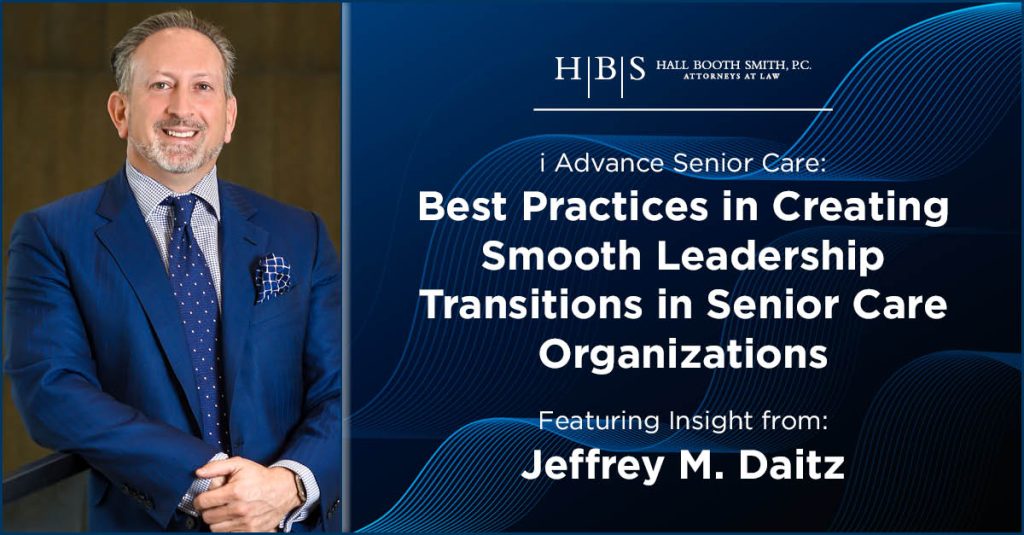
i Advance Senior Care: Jeffrey Daitz on Best Practices in Senior Care Leadership Transitions

Transitions in leadership can be defining times for senior care organizations. These transitions can be difficult to navigate, but upper-level management play a key role in how well staff are able to adapt to the change.
How Leadership Transitions Effect Senior Care Organizations
Good leaders bring stability and morale to senior care organizations. Jeffrey M. Daitz is a partner at Hall Booth Smith, P.C., co-chair of the Labor and Employment Law Group, as well as co-director of the Employment Practices Liability Insurance Defense Department. He explains that often, organizations hire someone for a senior leadership position, but they don’t give thought to how they introduce that person to the existing employees.
“People are naturally resistant to change,” says Daitz. “Often when there’s a transition, there’s often resentment. People internally sometimes resist change.” Daitz notes that offering lateral job opportunity advancements within the company can help to make that transition smoother and easier for existing staff to accept.
“Don’t just necessarily go outside of the company,” he suggests. “You might have some very talented employees who are interested in a senior position, but some companies do an outside search or work with a talent acquisition company. Sometimes it ignores the talent you already have internally.” Internal promotions can promote positive morale and help create a better employee-employer relationship. “If done the right way, the positive effect it has speaks volumes,” says Daitz.
Best Practices When Introducing New Leadership
In cases where that leadership position might not be the result of internal promotion, it’s important to introduce that person strategically and sensitively. Focus on ways you can make your current employees feel like they are a part of the decision-making process. Simply introducing a new CEO means your existing employees have no day. But if you have a discussion with your employees and explain that you’re looking to grow the business and are excited about the candidates you’ve been interviewing, the employees are able to be a part of the process.
When you do introduce a new hire, be prepared for your staff to turn to social media in an attempt to learn about that person. “Don’t leave it to the employees to research and find out about the person,” advises Daitz. “Bring them into the fold and do their homework for them.”
He notes that it’s important to maintain a positive culture throughout the transition. Sometimes new staff come in with their own managers, staff, and policies, and they start to change existing policies and practices that aren’t broken. “You should be able to build on existing policies and practices that work,” says Daitz. “Changing them creates tension between long-term employees who are now told that these policies don’t work.”
Most importantly, focus on creating an open dialogue where staff are able to discuss the changes in leadership and the times that are ahead. “Sometimes it’s as simple as having coffee and cake and having an open session where people can ask questions,” says Daitz. “It gives people more of a comfort level than being told after the fact that people are in charge. The open forum and town hall-type approach is a respectful way of letting people be heard.”
As for those who may be stepping into a new leadership position, Daitz notes the importance of recognizing the changes that COVID-19 has had on the workplace. “The last couple of years have been challenging for everybody,” Daitz says. Leaders need to recognize how the pandemic has transformed remote working, the effects it’s had on how workplaces accommodate staff, and the increased flexibility that’s needed in the workplace. “Take that and make sure you use that as a building block,” he says. “We have a lot of healing to do.”
Source: I Advance Senior Care


Leave a comment
You must be logged in to post a comment.